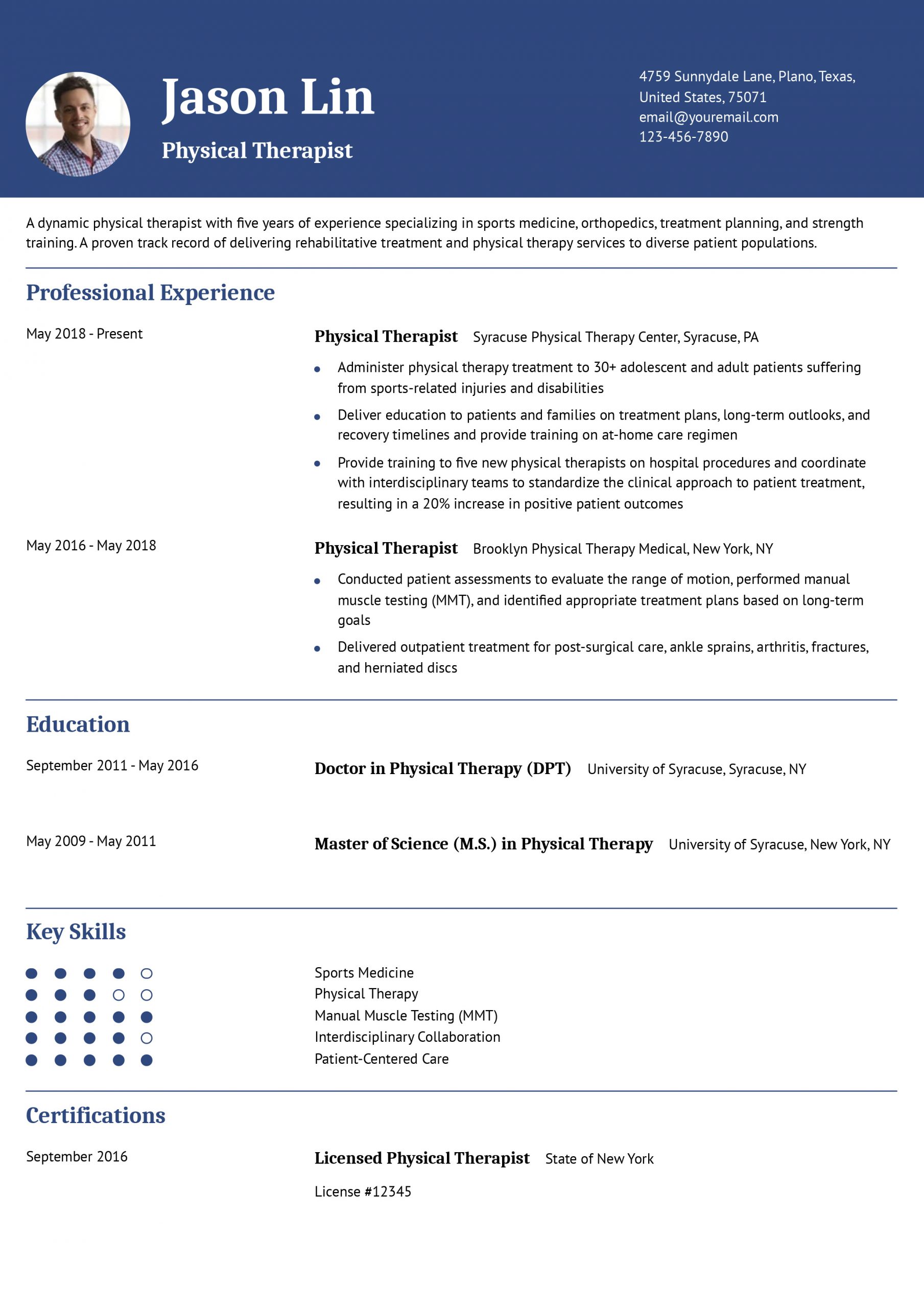How To Write a Physical Therapist Resume
As a physical therapist, your resume is vital in making a positive first impression on health care employers, demonstrating your qualifications, experiences, and dedication to patient care. Whether you’re an experienced practitioner or a recent graduate, a well-crafted resume can build a bridge to exciting career opportunities.
A good physical therapist resume will help you present your qualifications in the best possible light. Learn strategies to highlight your clinical knowledge, patient-centered approach, and proficiency in various treatment techniques. Also, we will show you real physical therapist resume examples with guidance for creating a document that reflects your passion for improving lives.
- Entry-Level
- Mid-Career
- Senior-Level
1. Summarize your physical therapist qualifications in a dynamic profile
When crafting your resume profile, focus on your specialized skills, patient-centered approach, and proven track record in providing effective rehabilitation services. Keep your profile concise, using two to three sentences to deliver a powerful introduction that captures the attention of hiring managers.
Establish credibility by mentioning the number of years you’ve practiced in the field and any special certifications you may hold. To engage readers, include an impressive stat or achievement showcasing your work’s impact. This is your opportunity to stand out as a top candidate, so make a strong first impression and entice readers to explore your resume further.
Senior-Level Profile Example
A licensed physical therapist with over 10 years of clinical experience, specializing in providing innovative physical treatment to patients suffering from chronic pelvic pain syndrome (CPPS). Adept at performing comprehensive patient evaluations to determine an accurate diagnosis and develop optimal treatment plans to achieve patient goals.
Entry-Level Profile Example
A licensed physical therapist with entry-level experience specializing in orthopedic outpatient care, rehabilitation, and patient-centered care. Adept at coordinating with multidisciplinary teams to deliver empathetic care and improve the quality of life for patients.
2. Add your physical therapist experience with compelling examples
Display your unique skills and expertise, but instead of listing all your duties and responsibilities, start by quantifying your experience wherever possible. Showcase the number of patients treated, a percentage increase in patient satisfaction scores, or improvements achieved during therapy. Include relevant clinical data if your efforts increased positive patient outcomes or recovery timelines. Incorporating numbers and metrics will help you tell your unique story within the health care space and make a lasting impression on prospective employers.
Additionally, start each bullet point with an action verb to infuse a dynamic element into your writing, highlighting your proactive approach and engaging employers with compelling language. With this strategy, you can distinguish yourself as a results-oriented professional who makes a positive difference in the lives of their patients.
Senior-Level Professional Experience Example
Physical Therapist
West Light Physical Therapy, San Francisco, CA | May 2016 – present
- Deliver physical therapy outpatient treatment to clients suffering from CPPS, evaluate symptoms related to bladder control, pain, and sexual function, and conduct treatment planning to relieve pain and improve quality of life
- Administer treatment to patients according to pain levels, revise treatment plans and clinical approaches based on progress, and improve positive patient outcomes by 15%
- Coordinate with interdisciplinary teams and chiropractors to guide treatment plans and employ a wide range of physical therapy modalities to drive patient recovery
Entry-Level Professional Experience Example
Physical Therapist
Penn Medicine Physical Therapy, Radnor, PA | May 2021 – present
- Deliver outpatient physical therapy treatment to 25 active patients, identify rehabilitation needs and treatment plans based on long-term goals, and adjust treatment regimen based on pain levels and patient progress
- Educate patients on strength-building exercises, physical therapy equipment, and at-home care and improve recovery timelines by 10% on average
- Interface with interdisciplinary teams to develop appropriate treatment plans and enhance the quality of care across the facility
3. Add physical therapist education and certifications
Establish your qualifications and expertise in the field with an education section. Employers want to see you have the necessary knowledge and skills to provide high-quality patient care. You must show you’ve completed the required coursework and passed relevant exams to become a licensed physical therapist. Starting with your highest level of education, list the degree name, institution, location, and graduation date.
Specific certifications in areas like orthopedics, neurology, pediatrics, or geriatrics can highlight your knowledge in specialized fields, making you a valuable asset to the organization. Physical therapists must meet specific educational and licensing requirements to practice legally, so including this information ensures compliance with regulations and provides confidence to employers. Create a separate certifications section and list each certificate name, issuing organization, and date received.
Education
Template
- [Degree Name]
- [School Name], [City, State Abbreviation] – [Graduation Month and Year]
Example
- Doctor of Physical Therapy (DPT)
- University of Syracuse, Syracuse, NY – May 2016
Certifications
Template
- [Certification Name], [Awarding Organization] – [Completion Year]
Example
- Licensed Physical Therapist, State of Pennsylvania – 2020, License #12345
4. List key skills and proficiencies for physical therapists
Including a key skills section demonstrates your capacity to deliver high-quality health care services and excel as a physical therapist. When listing skills, it’s essential to focus on those in direct alignment with the specific requirements of the job and the health care organization. Use a combination of hard skills (e.g., therapeutic techniques) and soft skills (e.g., communication and empathy) to present a well-rounded and versatile profile. Check out our list of examples below:
| Key Skills and Proficiencies | |
|---|---|
| Aerobics | Dry needling |
| Empathetic care | Health care |
| Hydrotherapy | Injury prevention |
| Interdisciplinary rehabilitation | Kinesiology |
| Manual muscle testing (MMT) | Musculoskeletal disorders (MSD) |
| Orthopedic rehabilitation | Outpatient treatment |
| Pain management | Patient assessment |
| Patient-centered care | Patient education |
| Patient management | Physical therapy |
| Rehabilitation plans | Sports injury |
| Sports medicine | Strength training |
| Treatment planning | |
How To Pick the Best Physical Therapist Resume Template
A template sets the stage for presenting your professional resume effectively. The best resume template for a physical therapist is clean and orderly, allowing hiring managers to quickly navigate your skills, experiences, and qualifications. Consider a professional design that complements the health care industry, but avoid overly elaborate or distracting layouts.
Simplicity and clarity are essential, so opt for a template that facilitates easy reading and highlights the most important aspects of your experience. The goal is to present your qualifications in the most compelling way possible, making it easy for employers to recognize your value as a physical therapist.
Physical Therapist Text-Only Resume Templates and Examples
- Entry-Level
- Mid-Career
- Senior-Level
Jason Lin
(123) 456-7890
[email protected]
123 Your Street, New York, NY 12345
Profile
A dynamic physical therapist with five years of experience specializing in sports medicine, orthopedics, treatment planning, and strength training. A proven track record of delivering rehabilitative treatment and physical therapy services to diverse patient populations.
Professional Experience
Physical Therapist, Syracuse Physical Therapy Center, Syracuse, PA
May 2018 – Present
- Administer physical therapy treatment to 30+ adolescent and adult patients suffering from sports-related injuries and disabilities
- Deliver education to patients and families on treatment plans, long-term outlooks, and recovery timelines and provide training on at-home care regimen
- Provide training to five new physical therapists on hospital procedures and coordinate with interdisciplinary teams to standardize the clinical approach to patient treatment, resulting in a 20% increase in positive patient outcomes
Physical Therapist, Brooklyn Physical Therapy Medical, New York, NY
May 2016 – May 2018
- Conducted patient assessments to evaluate the range of motion, performed manual muscle testing (MMT) and identified appropriate treatment plans based on long-term goals
- Delivered outpatient treatment for post-surgical care, ankle sprains, arthritis, fractures, and herniated discs
Education
Doctor of Physical Therapy (DPT)
University of Syracuse, Syracuse, NY September 2011 – May 2016
Master of Science (M.S.) Physical Therapy
University of Syracuse, New York, NY May 2009 – May 2011
Key Skills
- Sports Medicine
- Physical Therapy
- Manual Muscle Testing (MMT)
- Interdisciplinary Collaboration
- Patient-Centered Care
Certifications
- Licensed Physical Therapist, State of New York, License #12345, 2016
- Basic Life Support (BLS), American Heart Association, 2016
Associations
- American Physical Therapy Association, (APTA), Member, 2016
Frequently Asked Questions: Physical Therapist Resume Examples and Advice
What are common action verbs for physical therapist resumes?-
Describing your accomplishments and finding the right words is often tricky, so we've curated a list of action verbs to help you accurately communicate your professional experience in physical therapy. Action verbs add a dynamic element to your writing, making it more engaging for readers. Create a vivid picture of your contributions as a physical therapist with these powerful words:
| Action Verbs | |
|---|---|
| Administered | Assessed |
| Communicated | Coordinated |
| Created | Delivered |
| Designed | Developed |
| Educated | Evaluated |
| Implemented | Improved |
| Managed | Optimized |
| Planned | Prescribed |
| Rehabilitated | Strengthened |
| Supported | Treated |
How do you align your resume with a physical therapist job description?-
According to the Bureau of Labor Statistics, employment for physical therapists is projected to increase by 17% between 2021 and 2031, much faster than average. Although the physical therapy field has high growth potential, you'll still face competition in the open market due to the lucrative nature of these positions. Tailoring your resume to the job you're applying for is essential in creating a standout resume.
Especially when applying for a specific physical therapist job opening, aligning your resume with the job description is a solid way to present yourself as the ideal candidate. To do this effectively, thoroughly review the job description and identify the key skills, qualifications, and responsibilities listed there. Feature your relevant experiences, certifications, and specialized training that align with the position. Use the organization's language and keywords to demonstrate your familiarity with their terminology and needs.
What is the best physical therapist resume format?-
The reverse chronological resume format is generally the most effective for physical therapists. This format focuses on your work history, emphasizing your career trajectory and professional dedication. It's a standard choice for physical therapists with a solid employment background.
However, the combination format might be more suitable if you're a new practitioner transitioning into physical therapy from a different field or if you have employment gaps. It lets you present your relevant skills and accomplishments before your work history. Ultimately, select a format based on your current professional circumstances and career goals.
Craft your perfect resume in minutes
Get 2x more interviews with Resume Builder. Access Pro Plan features for a limited time!









